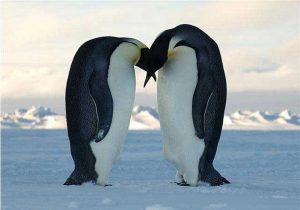Emperor Penguins are considered the tallest and heaviest of all other penguin breeds, reaching a height of up to 122 cm and weighing up to 45 kg. The females are a little less in both measurements. They are predominant located in Antarctica.

Emperor Penguins’ main source of food is primarily fish, including certain crustaceans or cephalopods, like krill or squid. During hunting, they may submerge in water for up to 18 minutes, reaching a depth of 535 m. What is interesting about these birds is that they contain unusual blood suited for low oxygen levels when they reach low depths in the ocean and solid bones to reduce the risk of barotraumas, which is damage caused to the body when undergoing differences in extreme pressurized environments. Also, penguins have the ability to lower their metabolism and shut down certain non-essential organs.
One may probably wonder how such a creature can survive in extreme environments. Well Emperor Penguins are notable for having many physical adaptations that allow them to live and tolerate freezing temperatures, highly pressurized conditions, and scarce locations. Penguins contain solid bones rather than an air pocketed skeletal system, which prevents breakage due to swimming in large depths under water. While swimming, their heart rates are reduced to five beats per minute, allowing them to ration their oxygen levels, as their intake is reduced as well. Also, to facilitate longer dives, certain organs stop functioning temporarily to allow them to become more energy efficient during hunting. They are equipped with barbed tongues pointing towards their throats, which help them catch prey and prevent the prey from escaping. They are covered in 100 feathers per every square inch of skin, making them the only bird species with the highest feather density. These feathers provide 80-90% of their insulation. They are also covered in a layer of fat under the skin that is as thick as 3 cm, hampering their movement on land.
Mating season begins around the coldest months of Antarctica, during March and April. A male will descend its head onto its chest and lift his head up towards the sky to give a courtship call for up to two seconds. He then walks around the colony and will continue his call until he finds a potential mate. The male will then lift up his head while the female synchronizes his same movements, and after several minutes, they will waddle around the colony with the female usually following the male. Before mating, the male will bow his head with his beak towards the ground and the female will do the same. Penguins usually will remain faithful to their mates, sometimes waiting for their previous partners from the year before to appear again. Several months after copulation, when the female lays her egg, she carefully transfers it to the males brooch over is feet. She then takes off for two months to feed while the male dedicates himself to keeping the egg warm. After the egg hatches, the mother will return around ten days later following her partner’s familiar call, discovering her newly born offspring.




